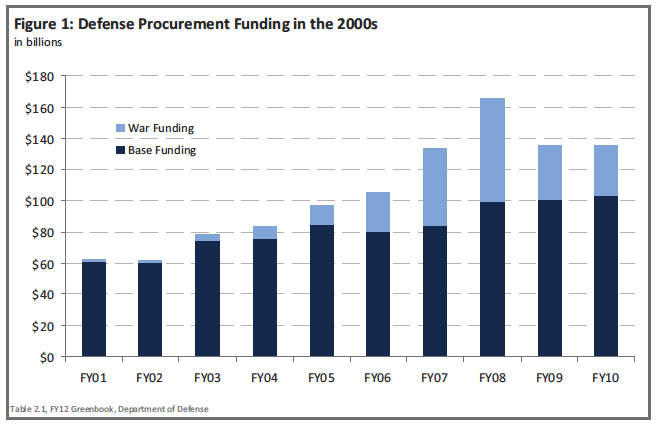
The light blue highlights war funding that went to buy weapons / Stimson Center
The Pentagon always insists that its peace-time budgets don’t fund any war-fighting. That’s why it’s always seeking so-called supplementals when the balloon goes up. But here’s a dirty little secret: the Pentagon has routinely used such budget add-ons to buy weapons that have little to do with day-to-day war-fighting.
The Henry L. Stimson Center issued an interesting report Friday that shed some needed light on the practice. It seems that $232.8 billion of the $1 trillion the nation spent on Pentagon procurement over the past decade – 22% — was part of these so-called wartime supplementals. That’s one of the reasons cutting back on weapons procurement is going to be so tough – as the supplementals evaporate, there won’t be those extra billions hidden away in the Pentagon cookie jar for new and improved arms.
Let’s take a step away from the wars and focus on military procurement spending: Pentagon weapons funding has more than doubled since 9/11, mushrooming from $62.6 billion in 2001 to $135.8 billion last year, according to Stimson’s Russell Rumbaugh. His bottom line, sometimes lost amid the fog of war:
Since FY01, we spent roughly $1 trillion on defense procurement, and the military services used that funding, including that provided in the supplemental war funding, to modernize their forces. In the daily barrage of news about cost overruns and cancelled programs, we can overlook this accomplishment. But after reviewing what procurement funding bought in the past decade, it is clear the military successfully modernized its capabilities, especially in building on existing systems and incorporating those not even anticipated.
Of course, you’d never know that if you wandered into the House Armed Services Committee readiness subcommittee hearing last Thursday, and listened to each service’s No. 2 officers plead poverty. Their scare stories – in light of that doubling in procurement spending over the past decade – were apt coming on the cusp of Halloween:
“What really concerns me is in the modernization area,” General Peter Chiarelli, vice chief of staff of the Army, told the panel. “I will tell you, the ground combat vehicle, the infantry fighting vehicle, is absolutely critical for the United States Army. We are not talking about going into full rate production at this particular time on the ground combat vehicle.”
“As we look to the future, I’d be concerned about two things,” said General Joseph Dunford, assistant commandant of the Marine Corps. “One, I’d be concerned that we actually do reset the force, we actually do address those deficiencies and replace that equipment that is worn out from operations in Afghanistan as we move to the future. The second thing I’d be concerned about is our ability to continue to modernize and keep pace with modern threats.”
The chairman of the House Armed Services Committee, Rep. Howard McKeon, R-Calif., toured Newport News Shipbuilding in Norfolk, Va., the day after the hearing, and said maintaining the U.S. Navy’s current carrier fleet – now at 11, and dipping temporarily to 10 next year – is vital. “I don’t want to see it go below that,” he said, “until they can show me the world is safer.”
The U.S. Navy, he pointed out, is what guards the world’s vital sea lanes that makes international trade possible. As the shipyard’s hometown paper, the Virginian-Pilot, noted:
Standing outside the shipyard’s corporate offices with the carrier Theodore Roosevelt behind him, McKeon said the Navy plays a critical role in the nation’s economy by keeping the sea lanes open for commerce.
“Without that presence that we’ve had around the world, we probably wouldn’t have the type of lifestyle that we’ve enjoyed all these years since World War II,” he said. “I don’t want to see that end.”


